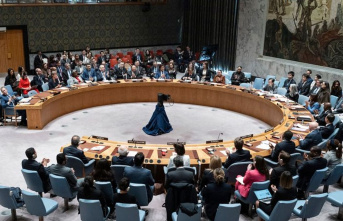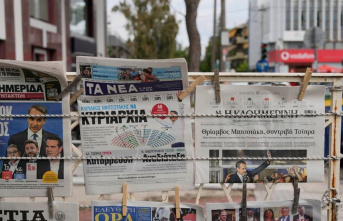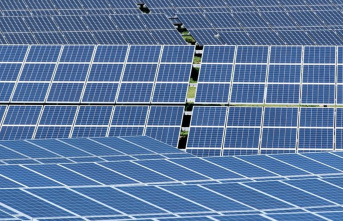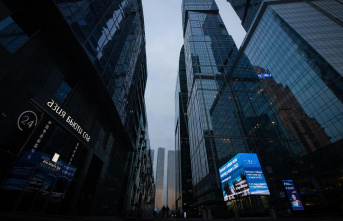Most recently, no gas flowed from Russia to Germany through the two Baltic Sea gas pipelines Nord Stream 1 and 2. The lines still cause concern. Apparently they are badly damaged.
On the night of Monday, a sharp drop in pressure was initially detected in one of the two tubes of the Nord Stream 2 pipeline. On Monday evening, the operator of Nord Stream 1 also reported a drop in pressure - in this case for both tubes. On Tuesday, the Danish energy authority announced that there were three gas leaks near the island of Bornholm - two leaks on Nord Stream 1 northeast of the Baltic Sea island and one on Nord Stream 2 southeast of the island.
The cause has not yet been clarified, the German press agency learned from security circles on Tuesday morning. However, there is a lot to be said for sabotage. If it were an attack, given the technical complexity, only a state actor would actually come into question. The "Tagesspiegel" had previously reported on this.
According to Polish Prime Minister Mateusz Morawiecki, the leaks are due to sabotage. "We don't yet know the details of what happened there, but we can clearly see that there was an act of sabotage," Morawiecki said on Tuesday in Goleniow near Szczecin, Poland, where he attended the opening of the Baltic Pipe gas pipeline. This act of sabotage is "probably the next level of escalation that we are dealing with in Ukraine."
Russia also does not rule out sabotage or other reasons. "Now no variant can be ruled out," said Kremlin spokesman Dmitry Peskov on Tuesday when asked whether sabotage could be the reason for the drop in pressure.
According to Nord Stream 2 spokesman Ulrich Lissek, the lines are laid in such a way that it is highly unlikely that several pipes will be damaged at the same time, for example by a single ship accident. When asked whether he was aware of similar incidents in connection with offshore pipelines, he said: "I've never heard of them." In an interview with the German Press Agency, an expert for underwater robots also referred to the extremely high safety standards and the very robust construction of the lines. From his point of view, only deliberate manipulation is possible.
Nobody has seen the leaks yet. But they can already be guessed at: The Danish military published the first recordings of a huge amount of bubbles on the water surface on Tuesday. The head of the Danish energy authority, Kristoffer Böttzauw, was quoted as saying by the newspaper Berlingske on Tuesday that "a really, really large amount of gas is currently flowing out of the leak at Nord Stream 2". This means that the water is extremely turbulent. In view of this amount of gas, it cannot be a small crack in the pipeline. "It's a really big hole," said Böttzauw accordingly. The areas in which the water surface is turbulent are therefore hundreds of meters in diameter.
At least directly above the gas leaks there is danger for shipping. According to the Danish Energy Agency, ships may lose buoyancy when entering the area. There is also a risk of ignition. There is no danger outside the zone, not even for the residents of Bornholm and the small neighboring island of Christiansø. The Danish shipping authority has set up appropriate restricted zones for shipping traffic.
In Germany, the Stralsund Mining Authority, which is responsible for the local pipeline sections, sees at least no immediate danger of the situation deteriorating: "From a technical point of view - based on the current status - it is unlikely that the damage will continue," the authority said on Tuesday. The pressure in the lines was set to a low level in accordance with the water depth.
The Bund für Umwelt und Naturschutz (BUND) estimates the possible short-term effects of the leaks on the Nord Stream 1 and 2 gas pipelines on the environment as locally limited. "However, there is a risk for the animals to suffocate. This particularly affects the animals that cannot escape quickly," said Nadja Ziebarth, head of the BUND marine protection office, on Tuesday. Like the German Environmental Aid (DUH), the BUND also sees escaping methane as a climate hazard.
Since one of the leaks is in Swedish territorial waters, crisis teams were convened in both Sweden and Denmark on Tuesday. When the leaks became known, the crisis management team, in which several ministries and authorities were involved, was called together, Swedish Foreign Minister Ann Linde told the Aftonbladet newspaper on Tuesday. The Danish Foreign Minister Jeppe Kofod contacted them, so virtual meetings were planned for the evening.
The operator of the Nord Stream 1 route does not want to remain idle either. Investigations are currently being carried out, said a spokesman for Nord Stream AG, which is responsible for Nord Stream 1. According to an expert on underwater robots, he assumes that the authorities will use diving robots to get an idea of the situation.
no Nord Stream 2 had not yet been put into operation. Russia stopped transporting gas through Nord Stream 1 on the morning of August 31. Since then, Germany has not received any natural gas from Russia. Nevertheless, the gas storage facilities in Germany can continue to be filled. Germany currently receives natural gas via pipelines from Norway, the Netherlands and Belgium. Daily totals have been increasing steadily since July 19th. According to the Federal Network Agency, German storage facilities are now 91.3 percent full. A further relief of the gas supply situation is expected for the turn of the year: through the planned commissioning of three terminals on the North Sea and Baltic Sea coasts for the landing of liquefied natural gas (LNG).
However, the price of European natural gas rose on Tuesday. The TTF futures contract for Dutch natural gas rose to around EUR 194 per megawatt hour. Most recently it was around 188 euros, which was around 8 percent more than the day before.












